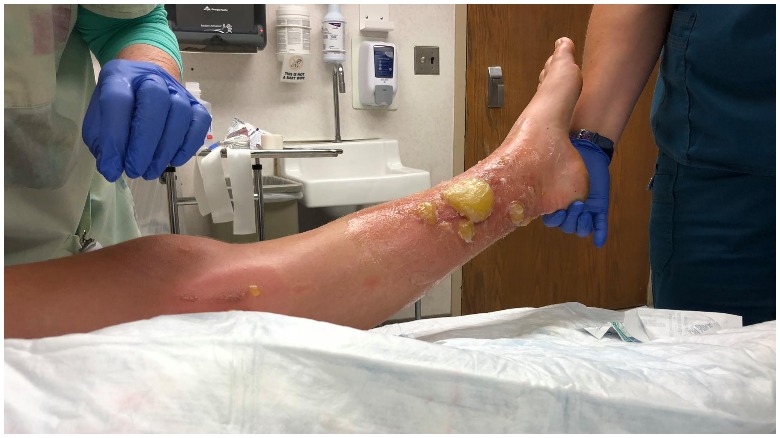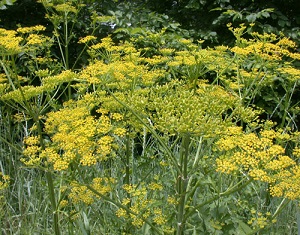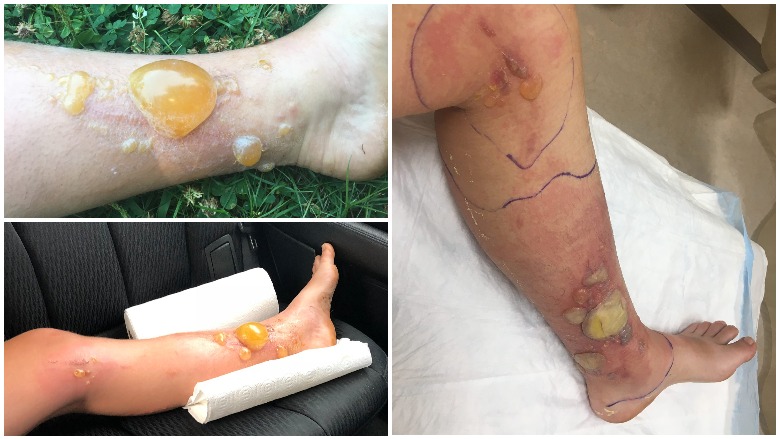
A woman in Vermont suffered extreme burns and blisters on her leg after coming into contact with a poisonous parsnip. 21-year-old Charlotte Murphy says she was walking alongside the road when she fell into the plant. She says she recognized the plant as a wild parsnip, but did not realize her fall had broken the leaves– therefore exposing her bare leg to the sap.
Murphy continued with her day out in the hot sun, unaware of the impact the poison was having on her skin. Within a couple of days, the pain and swelling had begun.
WARNING: The pictures below are graphic.
Here’s what you need to know.
1. Murphy Suffered the Equivalent of a Second Degree Chemical Burn
Murphy says she noticed a few small bumps on her leg a couple of days after the incident. They weren’t painful or itchy, so she continued her work outside in the sun. She described on her Facebook page that this continued exposure allowed “more sweat and UV rays to hit the skin, making the reaction that came a week later much worse than if I had washed my skin right away and stayed out of the sun.”
About a week after stumbling into the poison parsnip, her leg became itchy and red. Murphy says she must have scratched the infected area in her sleep, and woke up to large blisters. It became increasingly swollen and painful, and had begun spreading to her other leg, arms and fingers. Her parents rushed her to an urgent care.
Doctors were unable to drain the blisters, so they bandaged the area and gave Murphy antibiotics, according to Fox News. Murphy eventually had to seek treatment at the University of Vermont’s trauma and burn center. Doctors there told her she had suffered the equivalent of a 2nd-degree chemical burn. She’s expected to make a full recovery, but will likely have scarring.
2. The Toxic Sap From the Plant Essentially Causes an Extreme Sunburn

Charlotte MurphyCharlotte Murphy wants to raise awareness of the dangers of wild parsnip
Wild parsnip, which also goes by the name “hobo parsnip,” is actually fine to eat. The cream-colored roots and the leaves are edible. It’s the sap that is poisonous. The plant contains chemicals known as “furocoumarins” which cause a condition called “phytophotodermatitis.”
In plain English: your skin naturally protects you from the ultraviolet rays from the sun. The chemicals in the wild parsnip strip your skin of its ability to do that, which is why the exposed skin burns. It does this by destroying cells and skin tissue. When a person sweats, it speeds up this dangerous process.
The Wisconsin Department of Natural Resources explains that it mild cases, the skin merely feels sunburned. But in more extreme cases, like Murphy’s, massive blisters form. But the effects of the plant are not done once the blisters break and the area begins to heal. Wild parsnip also leaves behind a dark red or brown discoloration on the skin that can last for up to two years. The arms, legs, torso, face and neck are most vulnerable.
3. More People Are at Risk of Being Burned From Poison Parsnip Because It’s Spreading in the U.S.

NY Dept of Environmental ConservationWild parsnip
You could be at risk of being exposed to this wild plant because it is expanding rapidly across the United States. Originally from the Mediterranean, wild parsnip is an invasive plant. The Minnesota Department of Natural Resources explains the plant moves slowly into disturbed habitats, often along edges like the road that Murphy where walking. It can also be found in abandoned fields, pastures and prairies.
Once the plant takes root, it then can spread quickly and endanger the life of other plants in the area, according to the Wisconsin Natural Resources magazine. Wild parsnip can grow up to 70 inches in height. Land managers want the large, invasive plant removed before it can cause too much damage. It’s a frequent target during weed removal, so that’s one reason why more people are suffering the consequences associated with exposure to its sap.
4. Symptoms of Poison Parsnip Are Easily Confused with Other Ailments

Charlotte Murphy wants to raise awareness of the dangers of wild parsnip
After coming into contact with poison parsnip, the symptoms include:
– Large areas of blistering
– Itching
– Redness
– Inflammation
– Pain
– Tenderness
– Burning sensation
– Crusted patches of skin (once blisters burst)
These symptoms are often confused with other common issues, such as sun allergies, poison ivy, poison oak, and hives.
As explained earlier in this article, exposure to poison parsnip can cause phyto-photo-dermatitis. Photo means plant, photo means sunlight, and dermatitis is an inflammation of the skin. Other plants that can cause this condition include a few that may surprise you:
– Carrots
– Celery
– Citrus fruits (most commonly limes)
– Figs
– Wild dill
– Wild parsley
5. Get out of the Sun if You’ve Touched the Juice From a Wild Parsnip

Charlotte MurphyCharlotte Murphy wants to raise awareness of the dangers of wild parsnip
The immediate reaction after being exposed to the sap from a wild poisonous parsnip is to wash the affected skin. Get that juice off as soon as you can before it can spread. Its vitally important to get out of the sun. Heat and sweating will only speed the poison along. That’s why Charlotte Murphy’s condition worsened to the point that it did; she kept working out in the sun for days after the exposure
Doctors suggest cool washcloths to sooth moderate blisters. Steroids are prescribed in more severe cases. Corticosteroids creams can be helpful in easing the itching and bringing down inflammation.
Unfortunately, there is no fast cure for the discoloration that occurs on the skin once it begins to heal; this is called hyperpigmentation. The dark red or brown tint will fade over time. It’s best to stay out of the sun so the coloring does not darken.